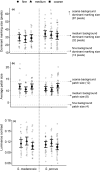Scorpionfish adjust skin pattern contrast on different backgrounds
- PMID: 38476704
- PMCID: PMC10928359
- DOI: 10.1002/ece3.11124
Scorpionfish adjust skin pattern contrast on different backgrounds
Abstract
The two scorpionfish species Scorpaena maderensis and S. porcus are well camouflaged ambush predators that rapidly change body colouration to adjust to background colour in less than 1 min. We tested whether individuals of both species also adjust body pattern to that of the background. We placed fish on backgrounds of different pattern granularity and quantified the change in fish body pattern over 1 min. We used calibrated image analysis to analyse the patterns from the visual perspective of a prey fish species using a granularity (pattern energy) analysis and an image clustering approach. In our experiment, fish did not change their most contrasting pattern components as defined by the dominant marking size, but changed their average marking size. Moreover, fish responded with a change in pattern in contrast to the different experimental backgrounds, especially when compared to the acclimation phase. These results indicate that scorpionfish have one main pattern that can be adjusted by modulating its internal contrast. A reduction in pattern contrast could thereby improve background matching, while an increase could promote camouflage via disruptive colouration.
Keywords: QCPA; background matching; camouflage; colour change; disruptive colouration; pattern energy analysis.
© 2024 The Authors. Ecology and Evolution published by John Wiley & Sons Ltd.
Conflict of interest statement
The authors declare that they have no competing interests.
Figures







References
-
- Barbosa, A. , Mäthger, L. M. , Buresch, K. C. , Kelly, J. , Chubb, C. , Chiao, C. C. , & Hanlon, R. T. (2008). Cuttlefish camouflage: The effects of substrate contrast and size in evoking uniform, mottle or disruptive body patterns. Vision Research, 48, 1242–1253. - PubMed
-
- Bond, A. B. , & Kamil, A. C. (2002). Visual predators select for crypticity and polymorphism in virtual prey. Nature, 415, 609–613. - PubMed
Associated data
LinkOut - more resources
Full Text Sources

